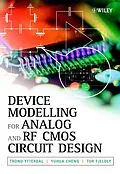* Bridges the gap between device modelling and analog circuit
design.
* Includes dedicated software enabling actual circuit
design.
* Covers the three significant models: BSIM3, Model 9 &, and
EKV.
* Presents practical guidance on device development and circuit
implementation.
* The authors offer a combination of extensive academic and
industrial experience.
Autorentext
Trond Ytterdal received the M.Sc. and Ph.D. degrees in electrical engineering from the Norwegian Institute of Technology, University of Trondheim, Trondheim, Norway, in 1990 and 1995, respectively. From 1995 to 1996, he was a Research Associate with the Department of Electrical Engineering, University of Virginia, Charlottesville. from 1996 to 1997, he was a Research Scientist with the Electrical, Computer, and Systems Engineering Department, Rensselaer Polytechnic Institute, Troy, NY. from 1997 to 2000, he was a Senior ASIC Designer with Nordic VLSI, Trondheim. Since 2000, he has been on the faculty of the Norwegian University of Science and Technology (NTNU), Trondheim.
He is the author of more than 100 scientific papers in international journals and conference proceedings. He is a coauthor of the books Semiconductor Device Modeling for VLSI (Prentice Hall, 1993), Introduction to Device Modeling and Circuit Simulation (Wiley, 1998), and Device Modeling for Analog and RF CMOS Circuit Design (Wiley, 2003). He has been a contributor to several other internationally published books. He is also a co-developer of the circuit simulator AIM-Spice. His current research interests include design of analog and mixed-signal integrated circuits, modeling of deep sub micrometer MOSFETs, MESFETs, HFETs, and novel device structures for application in circuit simulators.Prof. Ytterdal is a member of the Norwegian Academy of Technological Sciences.
Klappentext
In order to keep up with global demand, microelectronics engineers are continually challenged to produce increasingly complex, high performance integrated circuits. The steady downscaling of MOSFET/CMOS technology has highlighted the need for a thorough understanding of the properties, potentials and limitations of the latest device models and technology. Presenting state-of-the-art MOSFET models, this book will prove a valuable reference and text for engineers striving to achieve first-time-right, reduced time-to-market silicon products.
Featuring:
- A complete survey of the CMOS device models used in modern analog and RF integrated circuit design.
- A thorough treatment of the device modeling challenges faced by designers today.
- An examination of the most commonly used MOSFET models, including BSIM4 and EKV.
- A discussion of the modeling of process variations and device mismatch effects, along with device model quality assurance.
- Two accompanying software packages, AIM-Spice and MOSCalc, available via the Internet.
Zusammenfassung
- Bridges the gap between device modelling and analog circuit design.
- Includes dedicated software enabling actual circuit design.
- Covers the three significant models: BSIM3, Model 9 &, and EKV.
- Presents practical guidance on device development and circuit implementation.
- The authors offer a combination of extensive academic and industrial experience.
Inhalt
Preface.
MOSFET Device Physics and Operation.
MOSFET Fabrication.
RF Modeling.
Noise Modeling.
Proper Modeling for Accurate Distortion Analysis.
The BSIM4 MOSFET Model.
The EKV Model.
Other MOSFET Models.
Bipolar Transistors in CMOS Technologies.
Modeling of Passive Devices.
Effects and Modeling of Process Variation and Device Mismatch.
Quality Assurance of MOSFET Models.
Index.
